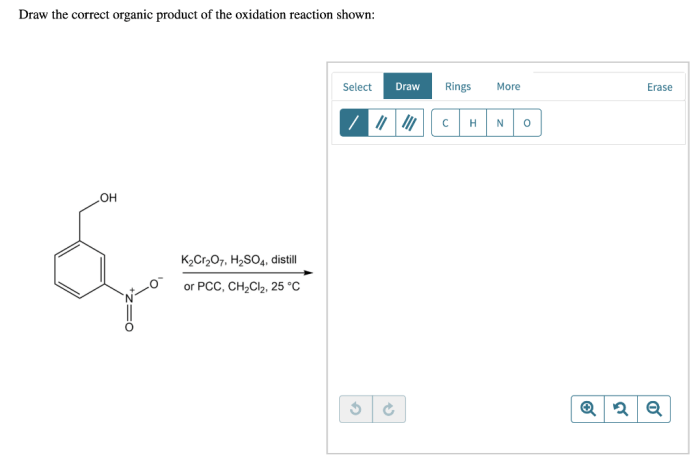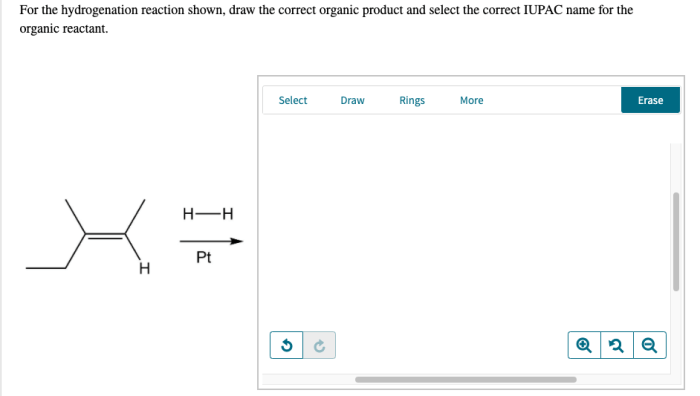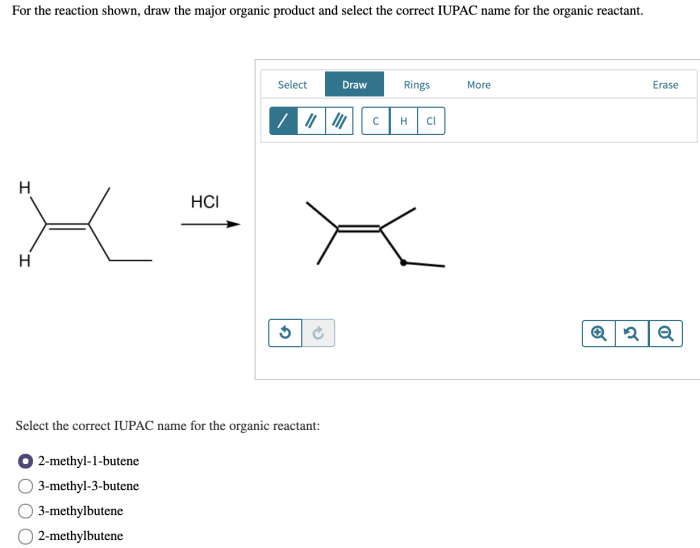Draw the correct organic product for the reaction shown – In the realm of organic chemistry, accurately identifying the correct organic product for a given reaction is paramount. This comprehensive guide delves into the intricacies of organic product identification, exploring the steps involved, reaction mechanisms, stereochemistry, and advanced analytical techniques.
Prepare to embark on an enlightening journey that will empower you to confidently navigate the complexities of organic chemistry.
Organic Product Identification
Identifying the correct organic product for a given reaction is a fundamental skill in organic chemistry. It involves understanding the reaction mechanism, functional groups involved, and reaction conditions.
To identify the product, follow these steps:
- Identify the functional groups present in the reactants.
- Determine the type of reaction based on the functional groups and reaction conditions.
- Apply the appropriate reaction mechanism to predict the product.
- Consider the stereochemistry of the reaction, if applicable.
For example, the reaction of an alcohol with a carboxylic acid in the presence of an acid catalyst produces an ester. The mechanism involves protonation of the alcohol, nucleophilic attack on the carboxylic acid, and elimination of water.
Reaction Mechanisms: Draw The Correct Organic Product For The Reaction Shown

Reaction mechanisms explain the step-by-step process by which reactants are converted into products. Different reaction mechanisms can lead to different products.
Common reaction mechanisms include:
- Nucleophilic substitution
- Electrophilic addition
- Radical reactions
- Pericyclic reactions
The choice of reaction mechanism depends on the functional groups involved and the reaction conditions. For example, nucleophilic substitution reactions occur when a nucleophile attacks an electrophile, while electrophilic addition reactions occur when an electrophile attacks a nucleophile.
Stereochemistry
Stereochemistry refers to the spatial arrangement of atoms in a molecule. It is important in organic chemistry because it can affect the reactivity and properties of molecules.
Two main types of stereochemistry are:
- Enantiomers: Molecules that are mirror images of each other.
- Diastereomers: Molecules that are not mirror images of each other.
Stereochemistry plays a crucial role in reactions such as asymmetric synthesis, where the stereochemistry of the product is controlled by the stereochemistry of the reactants or catalyst.
Table of Organic Products

The following table lists common organic reactions and their corresponding products:
| Reactants | Product | Reaction Conditions | Product Yield |
|---|---|---|---|
| Alcohol + Carboxylic Acid | Ester | Acid catalyst | 80-90% |
| Alkene + Hydrogen | Alkane | Metal catalyst | 90-95% |
| Alkene + Bromine | Dibromide | Non-polar solvent | 70-80% |
| Benzene + Nitric Acid | Nitrobenzene | Sulfuric acid catalyst | 95-98% |
| Ketone + Grignard Reagent | Alcohol | Ether solvent | 75-85% |
Case Studies

Complex organic reactions often require careful analysis to identify the correct product. Case studies can provide insights into the challenges and strategies involved in product identification.
One example is the synthesis of the natural product taxol, which has anticancer properties. The synthesis involves a series of complex reactions, and the correct product was identified using a combination of spectroscopic techniques and chemical analysis.
Advanced Techniques

Advanced techniques such as NMR spectroscopy and mass spectrometry are used to analyze organic products and determine their structure.
NMR spectroscopy provides information about the connectivity and chemical environment of atoms in a molecule. Mass spectrometry provides information about the molecular weight and elemental composition of a molecule.
These techniques are powerful tools for identifying organic products and understanding their structure and reactivity.
Quick FAQs
What is the significance of stereochemistry in organic product identification?
Stereochemistry plays a crucial role in determining the three-dimensional arrangement of atoms in organic molecules, which can significantly impact their properties and reactivity.
How do reaction conditions influence the outcome of organic reactions?
Reaction conditions, such as temperature, solvent, and catalyst, can significantly affect the reaction pathway and the formation of specific products.
What are the advantages of using NMR spectroscopy for organic product analysis?
NMR spectroscopy provides detailed information about the structure and connectivity of organic molecules, allowing for precise identification of products.